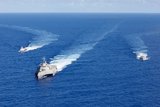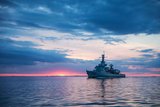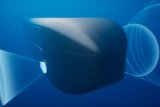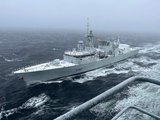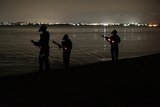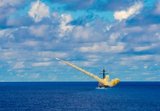FarSounder sonar for RNLN vessels
FarSounder’s 3D sonar systems have been selected for the Royal Netherlands Navy’s (RNLN’s) hydrographic survey vessels, the company announced on 30 July.
The company’s Forward-Looking Sonar (FLS) will provide the crew of HNLMS Snellius and HNLMS Luymes with real-time data that updates at every ping on their bridge regarding what lies ahead under the water as the ships navigate.
Snellius and Luymes carry out military and public safety operations, along with hydrographic survey duties in both the North Sea and the Netherlands Antilles. These duties include rapid environmental assessments, in addition to bathymetry and route surveys. The FarSounder FLS’ local history mapping capability allows for true real-time mapping of the seafloor. This map updates every two seconds and can be saved for future use.
The equipment will be installed as part of the vessels’ mid-life upkeep programme, being carried out by Damen Shipyards Den Helder.
More from Naval Warfare
-
![Maritime defence in the Mediterranean faces challenges from vulnerable land power]()
Maritime defence in the Mediterranean faces challenges from vulnerable land power
As an indispensable energy crossroads, the Mediterranean is at serious risk from grey zone disruption. As navies increasingly employ AI data centres, what happens when cutting-edge defence technologies rely on the very infrastructure most susceptible to hybrid tactics?
-
![Future Canadian Continental Defence Corvette will provide “Halifax-equivalent capabilities”]()
Future Canadian Continental Defence Corvette will provide “Halifax-equivalent capabilities”
Although the CDC project is still in its early stages, the Canadian Department of National Defence already has some requirements for the future platforms.
-
![US Navy to acquire micro-uncrewed underwater vehicles for ISR and coastal data collection]()
US Navy to acquire micro-uncrewed underwater vehicles for ISR and coastal data collection
The Naval Supply Systems Command is seeking authorised resellers of JaiaBot uncrewed underwater vehicles and multivehicle pods. The platforms will support undergraduate education at the US Naval Academy.
-
![US Navy advances with the Harpoon Service Life Extension Programme]()
US Navy advances with the Harpoon Service Life Extension Programme
The US Navy plans to improve Harpoon’s anti-ship and land attack capabilities by equipping the missiles with sensors and technologies required for succeeding in future battlespace.







